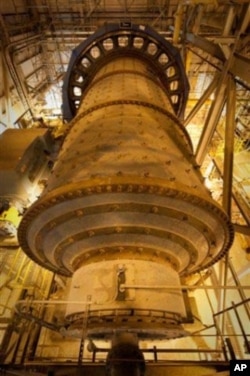The U.S. Environmental Protection Agency has stepped up efforts to cut dirty emissions from power plants. Its new Cross State Air Pollution rule targets pollutants caused by smog and acid rain. The mandate requires plants in 27 states to reduce sulfur dioxide and nitrogen oxide emissions that contribute to pollution problems in other states.
John Quinn, environmental affairs director for Constellation Energy, which owns a wide mix of power plants, says the company has worked hard over the past decade to reduce pollution at its coal-fired plant near Baltimore.
According to Quinn, the $800 million scrubber at its Brandon Shores coal-fired plant already reduces SO2 by 95 percent. That's better than the 73-percent target the federal law will require to protect states downwind.
“You can scrub the sulfur out of the air after it becomes part of the emissions stream," says Quinn. "And the sulfur falls out in a gypsum slurry and that product can be used in a variety of ways, including wallboard. So you make a positive use of that product.”
The cleaner air resulting from the new standard will save an estimated $280 billion per year in healthcare costs, according to EPA Assistant Administrator Gina McCarthy. She says that benefit far outweighs the estimated cost of capital investments and annual emissions reductions to comply with the new rule.
“As a result of this rule we will be reducing, starting in 2014 and every year thereafter 34,000 premature deaths, 1.8 million lost work days," says McCarthy. "These are significant health benefits for three-quarters of the U.S. population.”
Jeffrey Holmstead was the architect of a similar emissions-reduction standard when he served as assistant administrator of the EPA under former President George W. Bush. That mandate was thrown out by a federal judge in 2008 for not meeting the requirements of the Clean Air Act.
Holmstead thinks the new rule will survive judicial challenge. But he’s concerned about how power plant operators will respond to other EPA rules still on the way.
They include mercury and air toxics standards. EPA is also expected to rule later this year on climate-changing greenhouse gas emissions, such as carbon dioxide. Holmstead says the costs of complying with such rules will make it hard for utilities and factories to run profitably in an already difficult U.S. economy.
“I think that EPA’s view is the cost is acceptable and I think the industry’s view is that EPA is really underestimating the cost and especially given the tight time frames, EPA has said that people have to comply in some cases six months, in some cases, a few years, but not nearly the amount of time that is normally given in these kinds of regulations.”
Holmstead, like many politically conservative critics of the EPA, fears the regulatory climate will cause many U.S. manufacturers either to shut down their operations or move their factories overseas.
“We’ve already seen in the U.S. that the manufacturing sector has shrunk and with the number of new requirements coming out of EPA, I think there’s significant concern, especially in areas where we have heavy manufacturing today that they just won’t be competitive in global markets, given the increase in the cost of electricity.”
That’s not the scenario envisioned by EPA officials. Current Assistant Administrator McCarthy says power plant upgrades like those at Constellation Energy can create thousands of new jobs. And she says the new rules make industries more competitive by requiring that older, dirtier plants either close or comply with the same clean-air rules as newer facilities.
McCarthy notes that proposed agency rules for reducing mercury and other toxic air pollutants have been delayed for decades and she believes it’s past time for the EPA to act. “Believe it or not that in this country nationally we have no national standard for toxics, for the largest sector that emits toxic pollution. So we regulate over 90 industry sectors for toxics. We have failed to regulate the power sector, which emits more toxics than all of the rest of them.”
While critics of the agency in Congress and private industry oppose tighter regulations because of concerns about their potential economic harm, EPA’s Gina McCarthy says the new rules make sense, both for the U.S. economy and for public health.
“We’re doing what we’re supposed to do. We’re implementing the Clean Air Act and we’re doing it in the most cost effective way that we can and we recognize that people are concerned about jobs. People are concerned about the economy. We see that. We factor cost into the rules we do and know that we don’t have to make choices between people breathing clean air and the economy.”
Back at the Brandon Shores power plant near Baltimore, environmental affairs manager Quinn says Constellation Energy has kept pace with change.
“It justifies the expenditures that we made over the last ten years in cleaning up our emissions.”
Constellation Energy has managed to stay ahead of the regulatory curve. EPA officials hope its compliance with the stricter clean air rules will be a model for other U.S. companies. And they hope that success will strengthen the agency’s case against its vocal and powerful critics.











